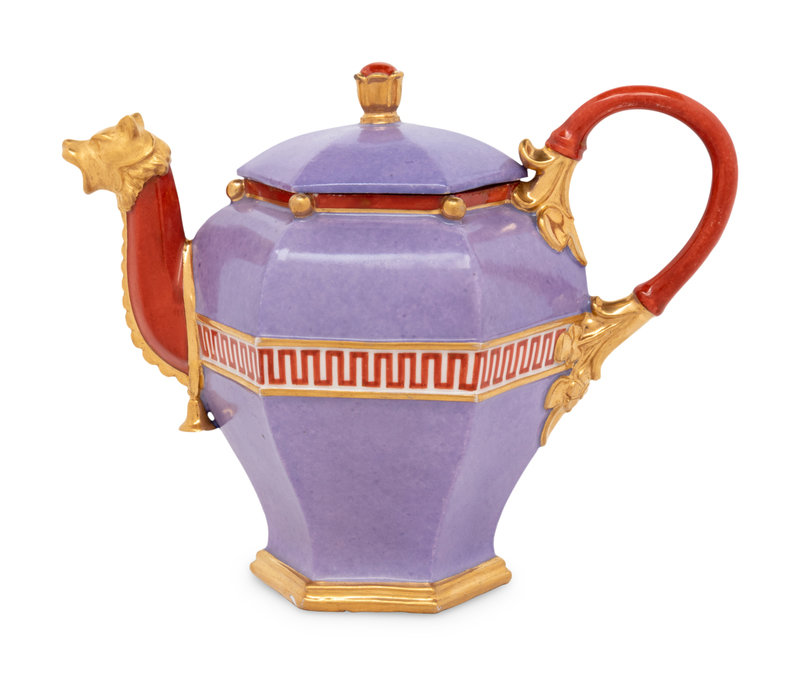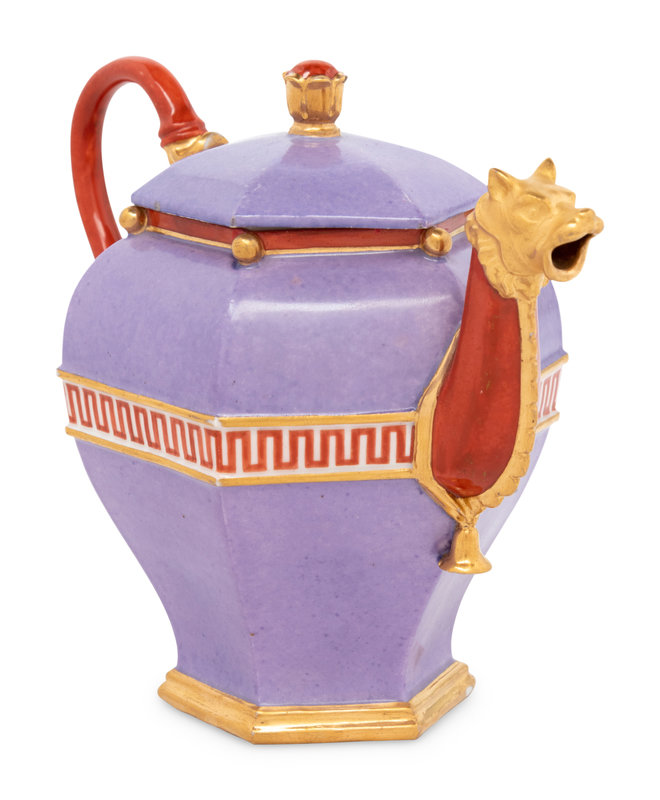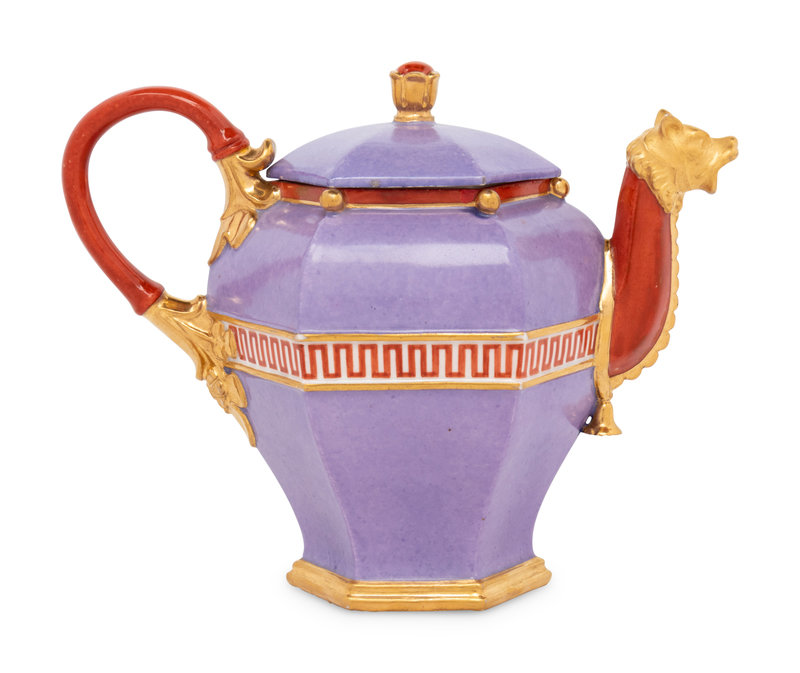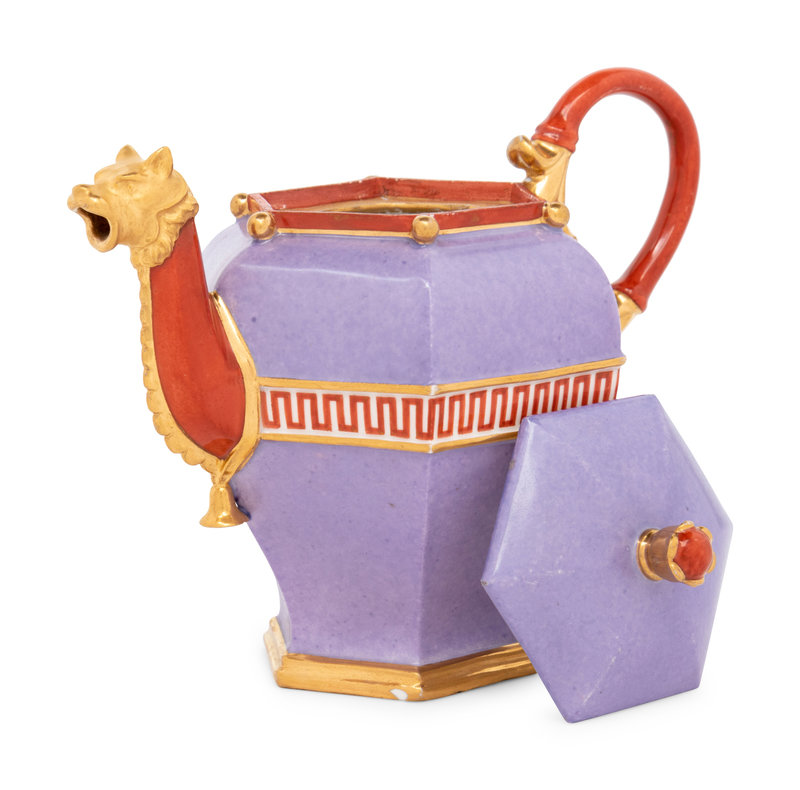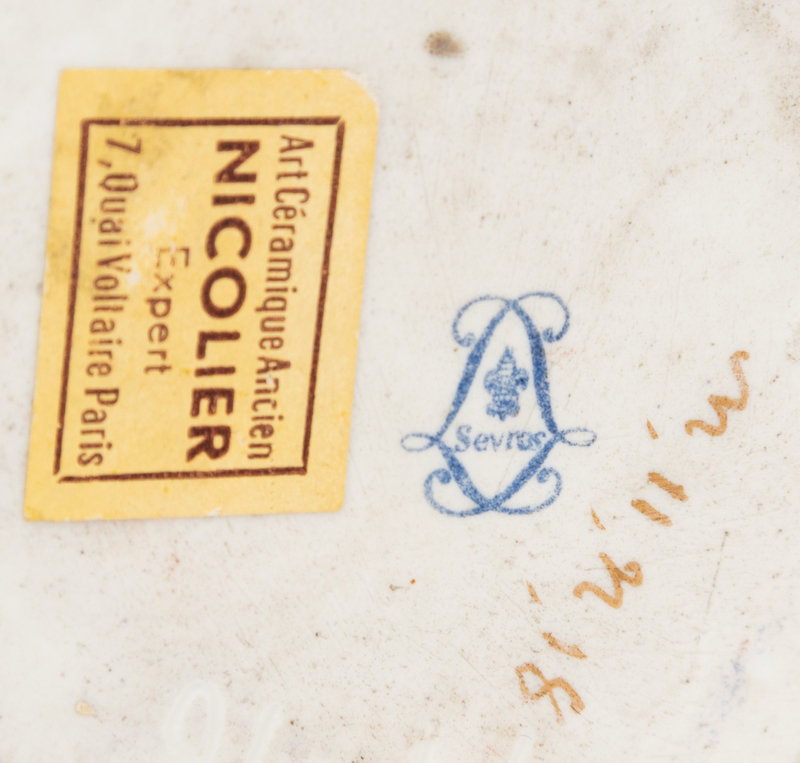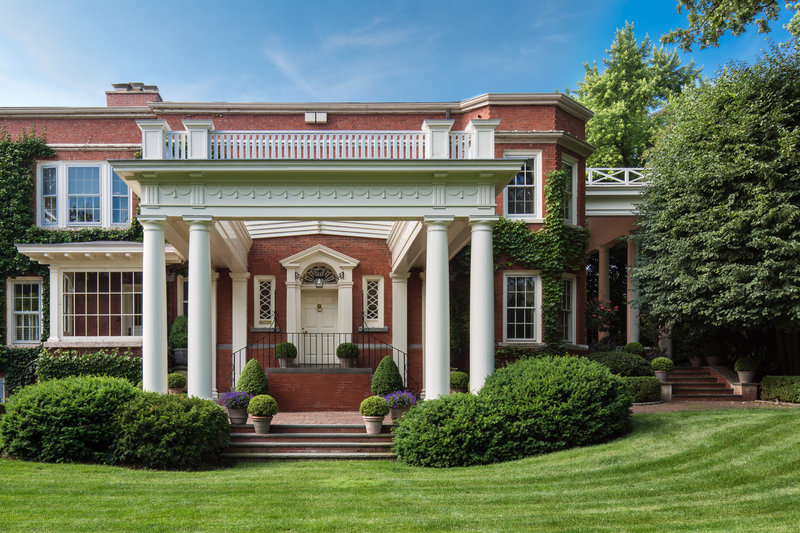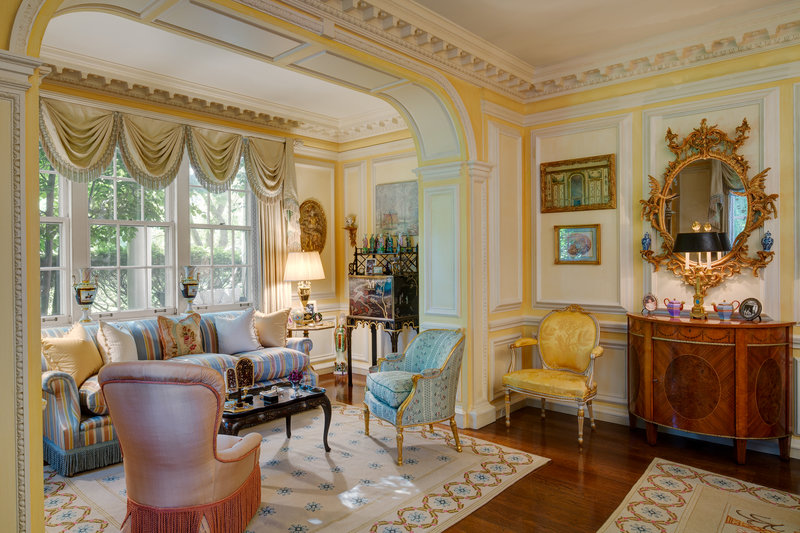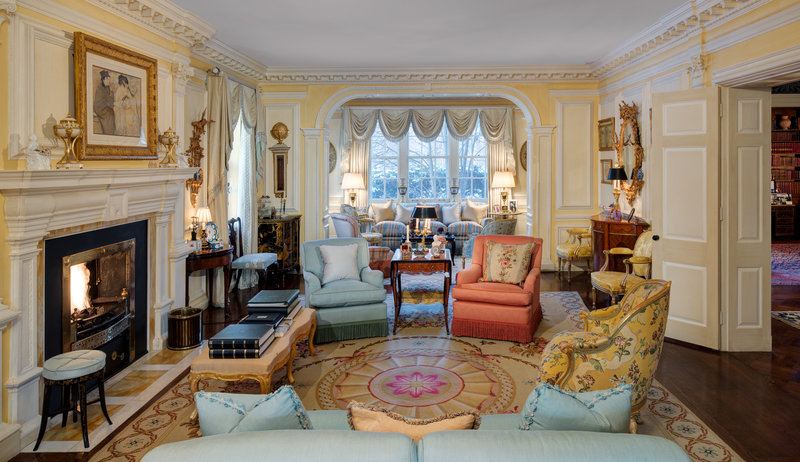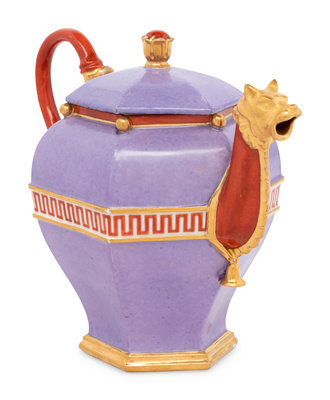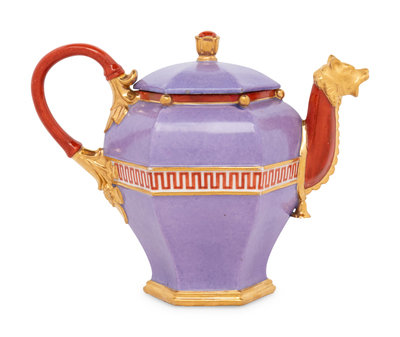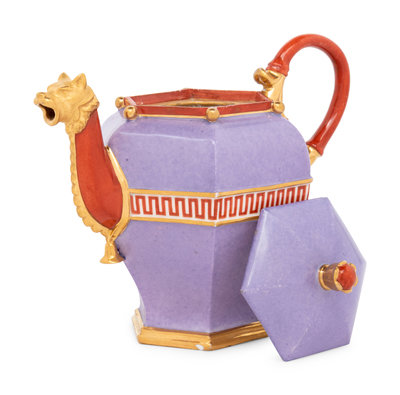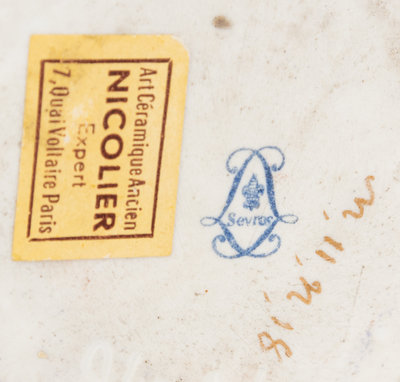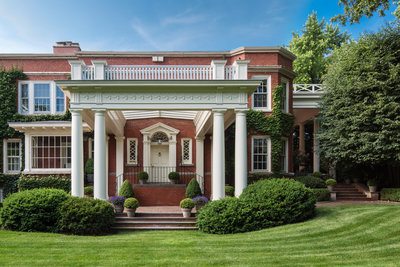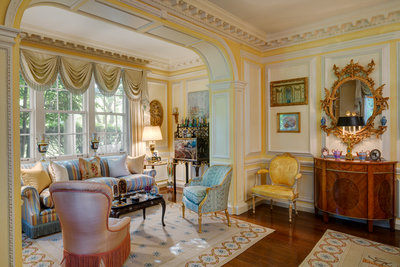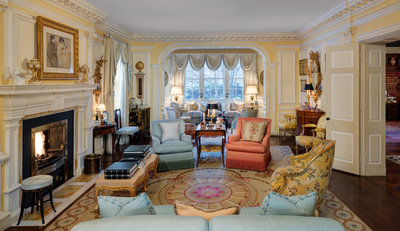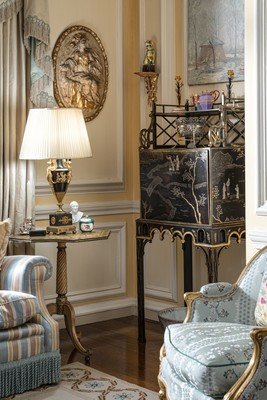Lot 103
A Sèvres Lilac-Ground Hexagonal Hard-Paste Porcelain Teapot and Cover (Théière 'Chinoise Fragonard')
Sale 1157 - Property from the Fred and Kay Krehbiel Collection, Part I
Mar 15, 2023
10:00AM CT
Live / Chicago
Own a similar item?
Estimate
$7,000 -
9,000
Price Realized
$20,160
Sold prices are inclusive of Buyer’s Premium
Lot Description
A Sèvres Lilac-Ground Hexagonal Hard-Paste Porcelain Teapot and Cover (Théière 'Chinoise Fragonard')
Circa 1819
bearing stenciled blue interlaced Ls enclosing a fleur-de-lis mark with incised kiln date cypher 14-10 for October 1814 and gilt m, 11, n, 18 (sic) M... for gilding on 11 November 1818 (sic) possibly by Moyer; the hexagonal baluster pot with conforming slightly domed hexagonal cover with gilt coral flower finial, a molded gilt-edged central frieze painted in coral red with a key pattern, the applied upright loop handle also coral with stylized gilt leaf terminals, the angled faceted spout with gilt wolf-head mouth with a bell suspended as the terminal, the neck of the pot coral with a gilt ball resting at the angle of each of the six facets.
Height 5 1/2 inches.
This lot is located in Chicago.
Provenance:
Nicolier, Paris (labeled)
Dragesco-Cramoisan, Paris, 16 June 1995 (purchased at the International Ceramics Fair, London; with invoice)
Exhibited:
New York, Bard Graduate Center for Studies in the Decorative Arts, The Porcelain Manufactory at Sèvres, 1800-1847: Alexandre Brongniart and the Triumph of Art and Innovation, 14 October 1997-31 January 1998, cat. no. 47
Washington, D.C., Hillwood Museum and Gardens, Sèvres Then and Now: Tradition and Innovation in Porcelain 1750-2000, 12 September-10 December 2006, cat. no. 41
Literature:
Tamara Préaud, ed., The Porcelain Manufactory at Sèvres, 1800-1847: Alexandre Brongniart and the Triumph of Art and Innovation, Exhibition Catalogue, Bard Graduate Center for Studies in the Decorative Arts, 1997, cat. no. 47
Liana Paredes, Sèvres Then and Now: Tradition and Innovation in Porcelain 1750-2000, London, 2009, cat. no. 41, pp. 84-85
Note:
Designed for Sèvres by Alexandre-Evariste Fragonard in April 1818, the thèière chinoise Fragonard was put into production immediately. The present teapot and the other example in this sale (lot 104) are two of the earliest examples made, the form produced between 1818 and 1846 as a stand-alone teapot. Later examples featured more elaborate decoration such as that of 1827 now in the collection at Sèvres-Cité de la céramique (MNS 24.784).
Three of the five easily located extant examples were at one time in the collection of Mr. and Mrs. Fred Krehbiel. The third, an agate blue-ground pot painted and gilt in the style of Chinese cloisonné enamel, purchased from Dragesco-Cramoisan in October 2006, was a gift to the Art Institute of Chicago in 2010.
Fragonard was paid 30 francs for his design. His watercolor of it, retained in the factory’s archives (2011.3.900, reproduced here), is almost identical to the present pot, with decoration of a coral red fretwork frieze enriched in gilt on a powdered lavender ground.
The salesroom entry records for 26 December 1818 include the first eight examples of the thèière chinoise Fragonard. The Sèvres factory held its annual selling exhibition at the Palais du Louvre 29 December 1818-8 January 1819. In total, seventeen examples are recorded between 1818 and 1821, each priced at 36 francs. These were almost certainly a solid ground color with a fretwork frieze similar to the two examples in the present sale. The present example, with its incised kiln date of October 1819 is obviously from this group.
Two with a blue ground enriched in gilt and priced at 55 francs may be similar to an example of 1819-1820 sold at auction at Drouot by Audap & Associés, Paris, 10 December 2020, lot 134. Between 1827 and 1846, eight further examples of the form are recorded with richer decoration. The teapot now at the Art Institute dated 1832-1835 (2010.583a-b) may be from this group.
The factory markings on this teapot present a conundrum, in that the gilder’s mark appears to predate the kiln date. The incised kiln date 19-10 is written in a typical 18th century hand, the loop of the 9 not closing completely. It is the inscribed gilding date of 1818 that must be incorrect. M…. may be for Jean-Louis Moyer (active 1818-1848), recorded at Sèvres as a gilder who used a wide capital M as his mark. Looking at the dates involved, the present teapot with its patently incorrect gilding year will have been one of his first pieces, so perhaps one can excuse the error.
Photo Credit: © RMN-Grand Palais / Art Resource, NY
Condition Report
Contact Information
Auction Specialist
